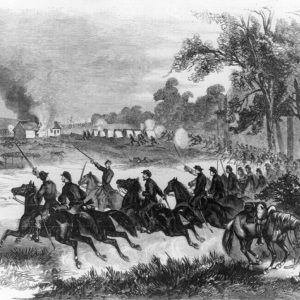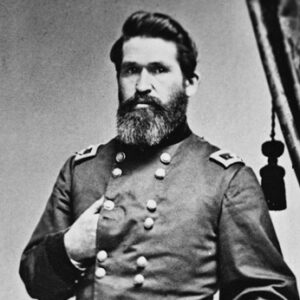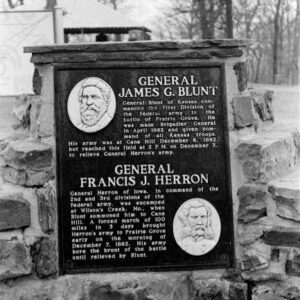calsfoundation@cals.org
James G. Blunt (1826–1881)
aka: James Gilpatrick Blunt
James Gilpatrick Blunt had several careers and titles during his lifetime, including doctor, ship’s captain, and major general of volunteers in the U.S. Army during the Civil War. Blunt’s command saw fighting principally in the border region of Kansas, Missouri, Arkansas, and Indian Territory (now Oklahoma). In Arkansas, he led his troops to victory at the battles of Cane Hill, Prairie Grove, Devil’s Backbone, Boston Mountains, and Van Buren. In 1864, Blunt’s troops were a part of the Union forces that repulsed General Sterling Price’s raid into Missouri.
James G. Blunt was born in Trenton, Maine, on July 21, 1826. He was the son of John Blunt, a local farmer, and Sally Gilpatrick Blunt. The young Blunt satisfied his wanderlust by becoming a sailor on a merchant ship at the age of fifteen. He became captain of his own vessel in just five years. In 1845, he moved to Columbus, Ohio, and enrolled at Starling Medical College. He married Nancy G. Putnam in 1850, and they had two children.
An ardent abolitionist and a Republican, he moved to Kansas in 1856 and became involved in the bloody border conflict over slavery. During a confrontation with the Kansas pro-slavery state government, Blunt joined a militia force that included abolitionist John Brown and his followers. He also served on the committee that wrote the Kansas state constitution.
At the start of the Civil War in 1861, Blunt was appointed lieutenant colonel of the Second Kansas Volunteer regiment. On April 18, 1862, he was made a brigadier general of volunteers and given command of the Department of Kansas. His division was later renamed the Army of the Frontier. Blunt’s division consisted of Kansas volunteers as well as Cherokee, Creek (Muscogee), and Seminole Home Guard units. He saw the need to raise volunteers among the Native American tribes that remained loyal to the United States. Three Indian regiments were organized. One of these regiments, the Third Indian Home Guard, consisted of 1,200 men and was formed from a Confederate regiment of Cherokee that had defected to the Union cause.
The high point of Blunt’s army career most likely came when he served as a division commander at the Battle of Prairie Grove. While still at Cane Hill (Washington County) on December 7, 1862, Blunt could hear the roar of battle and ordered his troops to march to the sound of the guns. Instead of marching along the roads, the Union soldiers advanced at the double quick across farm fields and fences. Using this unorthodox maneuver, Blunt’s forces arrived on the field just in time to help Brigadier General Francis Herron’s Federal troops, who found themselves being attacked on three sides. Blunt’s troops surprised the Confederates and drove them back. The general was later credited with saving Herron’s divisions. Even though the battle was a tactical draw, the Union remained in control of the battlefield.
Blunt was appointed major general of volunteers on March 16, 1863. He was the only Kansan to attain that rank during the war. He personally commanded the victorious Union forces at the Battle of Honey Springs in Indian Territory. After the battle, Fort Gibson was renamed Fort Blunt in his honor.
On October 6, 1863, after Blunt had turned command of Fort Smith (Sebastian County) over to Colonel James N. Johnson, a Confederate guerrilla force led by William C. Quantrill attacked a wagon train led by Blunt near Baxter Springs, Kansas, killing more than eighty of the 100-man detachment. Blunt barely escaped. Among the dead was his adjutant, Major Henry Curtis, son of Major General Samuel Curtis. Due to this debacle, Blunt was removed as commander of the Army of the Frontier.
In 1864, Blunt redeemed himself as the commander of the First Division of the Army of the Border. His unit, along with Alfred Pleasanton’s cavalry, fought to delay Major General Sterling Price’s Confederate advance into Missouri. Several battles followed, but Gen. Curtis was able to gather his forces and defeat Price at the Battle of Westport, Missouri. Blunt’s cavalry then attacked Price at the Second Battle of Newtonia, causing a Confederate retreat.
After the war, Blunt settled in Leavenworth, Kansas, and resumed his medical practice. He was also admitted to the Kansas bar to practice law. He moved to Washington DC in 1869 and served as a solicitor of claims agent, preparing claims for clients in order for them to proceed to trial.
In February 1879, the former general’s behavior became erratic, and he was committed to an asylum. Blunt died on July 27, 1881, with the cause of death listed as “softening of the brain.” This is caused by hemorrhage or inflammation. His body was returned to Leavenworth, and he is buried in the Mount Muncie Cemetery.
The Kansas State Historical Society has several of Blunt’s personal items in its collection. The items include flags; his major general’s epaulets, sword, and sash; and a gold-plated Henry rifle that was given to him by the officers on his staff.
For additional information:
Bailey, Anne J., and Daniel E. Sutherland, eds. Civil War Arkansas: Beyond Battles and Leaders. Fayetteville: University of Arkansas Press, 2000.
Banasik, Michael E. Embattled Arkansas: The Prairie Grove Campaign of 1862. Wilmington, NC: Broadfoot Publishing Company, 1996.
Baxter, William. Pea Ridge and Prairie Grove: Scenes and Incidents of the War in Arkansas. Fayetteville: University of Arkansas Press, 2000
Bearss, Edwin Cole, and A. M. Gibson. Fort Smith: Little Gibraltar on the Arkansas. Norman: University of Oklahoma Press, 1969.
Bishop, A. W. Loyalty on the Frontier, or Sketches of Union Men of the South-West with Incidents and Adventures in Rebellion on the Border. Edited by Kim Allen Scott. Fayetteville: University of Arkansas Press, 2003.
Blunt, James G. “General Blunt’s Account of His Civil War Experiences.” Kansas Historical Quarterly 1 (May 1932): 211–265. Available online at http://www.kancoll.org/khq/1932/32_3_blunt.htm (accessed March 2, 2022).
Christ, Mark K., ed. Rugged and Sublime: The Civil War in Arkansas. Fayetteville: University of Arkansas Press, 1994.
Collins, Robert. General James Blunt: Tarnished Glory. Gretna, LA: Pelican Publishing Company, 2005.
Lause, Mark A. Price’s Lost Campaign: The 1864 Invasion of Missouri. Columbia: University of Missouri Press, 2011.
Shea, William L. Fields of Blood: The Prairie Grove Campaign. Chapel Hill: University of North Carolina Press, 2009.
———. War in the West: Pea Ridge and Prairie Grove. Abilene, TX: McWhiney Foundation Press, 2001.
Steven L. Warren
Overland Park, Kansas
 Military
Military Battle of Honey Springs
Battle of Honey Springs  James Blunt
James Blunt  Blunt-Herron Monument
Blunt-Herron Monument 




Comments
No comments on this entry yet.